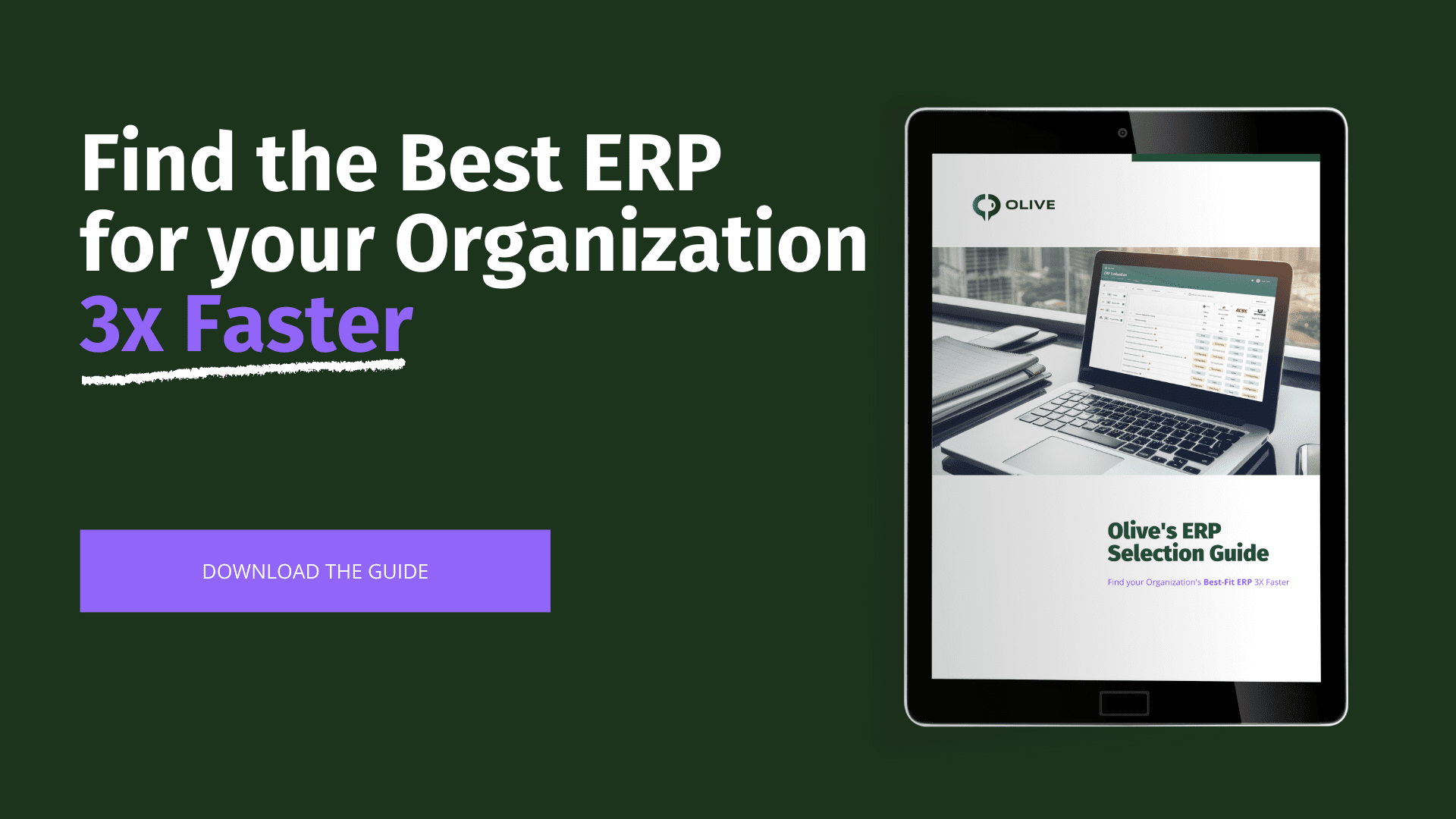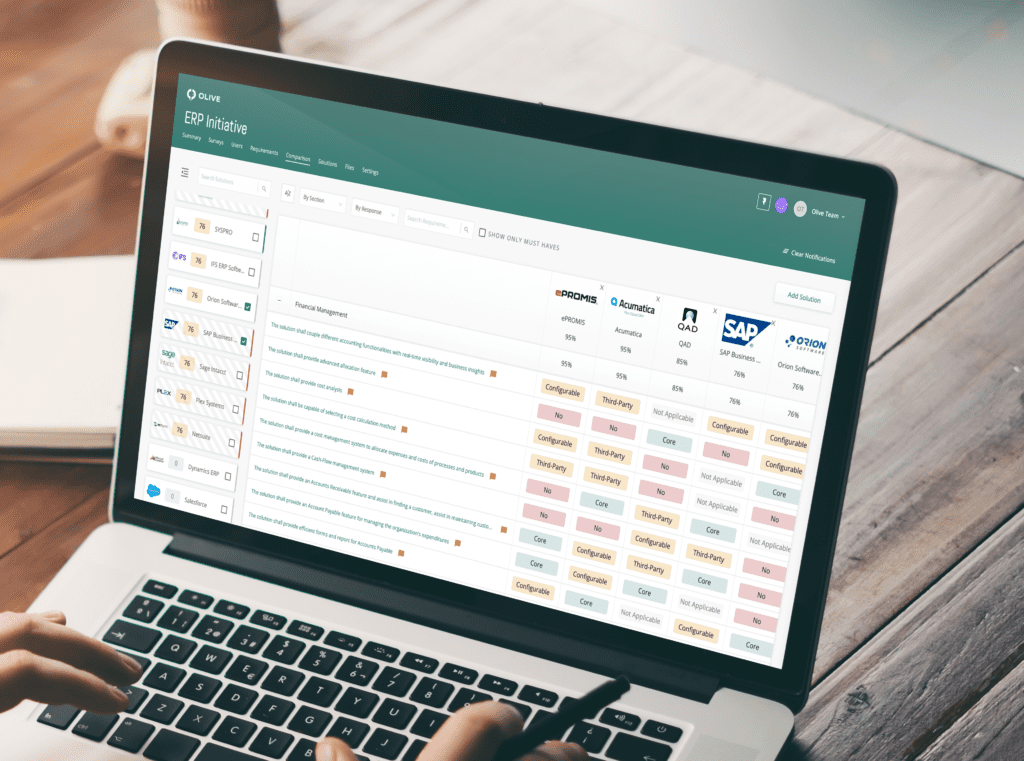Searching for the best ERP for Retail Enterprises is no easy task. Here’s how to choose the best Enterprise ERP for Retail, including a step-by-step guide, industry trends, and key considerations for choosing the right solution in 2024.
What is ERP Software?
An ERP system is software that allows your business to manage all aspects of its day-to-day operations, from accounting to project management to compliance. It undergoes continuous updates to provide real-time data to everyone in the business who has access to it. ERP software is one of the most comprehensive solutions for companies in need of back-end organization, with features tailored to businesses of all sizes and industries. An ERP system allows companies to centralize many key elements of their production line, building a more productive and cost-effective business model.
What’s the ‘Best’ Retail ERP Software?
Although there are a number of high contenders across the retail ERP leaderboard, the ‘best ERP’ is the one that meets the unique needs of your business. Not the first search result on Google, or the highest reviewed system on G2. Identifying which one is best for your business needs is traditionally a slow and manual process. Unless you conduct a thorough ERP evaluation, you will never understand which ERP system is best for your business’ specific needs, and why.
Comparing different retail ERP systems’ functionalities and features is one of the best ways to get a better idea of the return on investment (ROI) you’ll receive from each one. With this in mind, let’s run through some ERP considerations for retail below:
Retail Cloud ERP Software Considerations: Features and Functionality
While most retail ERP software solutions offer similar functionality, they each have their own features and specialties to take into consideration. Here is a list of the top five retail ERP software features to prioritize when choosing your solution:
1. CRM Integration
CRM modules integrated into your ERP system give you a 360-degree view of customers. From CRM data, you can discern your customers’ product preferences and spending patterns in order to better personalize your products and services to their needs. CRM modules can also help you manage customer complaints and returns more efficiently, as well as track the success of marketing campaigns, setting you up for future improvements and success.
2. Multi-channel management
With the huge uptick of e-commerce, retailers and brands that don’t offer it are at risk of losing customers to competitors who do. For companies that do not have the budget or resources to run their own e-commerce store, a retail ERP system with multi-channel management is a great option. It allows you to manage your online marketplaces, branded ecommerce sites, and more from a single system. Your business can improve productivity, reduce costs, increase customer satisfaction, and have more control and reach.
3. Business intelligence (BI) and demand forecasting
To make critical business decisions, accurate data is essential. Your retail ERP business management system synchronizes every aspect of your business, making it ideal for this purpose. However, the volume of data involved in day-to-day business operations can be overwhelming, and accurate data analysis needs to be extracted, manipulated, filtered, and sorted – leading to a time-consuming and error-prone process. With business intelligence (BI), you can collate and convert data from your ERP, and easily convert it into strategic insights and performance metrics. Additionally, demand forecasting allows you to use historical sales data and current market conditions to make accurate decisions, maximize sales, reduce inventory carrying costs, and positively impact your bottom line.
4. Real-time inventory management
Modern retail ERP systems can track your stock in real time across your supply chain, updating instantly each time a purchase is made. This data repository can provide global stock availability, providing you and your POS network with real-time updates across channels. Great retail ERP solutions record not only the number of items but also their condition, and also track the value of your inventory. By combining all this information, you gain better inventory control and control, helping you to streamline and automate your inventory management process.
5. Comprehensive supply chain management
When used with an ERP system, the supply chain management module will show where your products are and provide smooth transportation. Furthermore, a supply chain management module can help you with accounting through the ERP software— it can track checks, create purchase orders, and more. You can also track the quantity and quality of products ordered through the system, as well as the suppliers from which they were ordered.
Vendor Scoring Criteria for Retail ERP Systems
1. Speed & Flexibility
All retailers need the ability to scan each item quickly and allow various payment methods, and be able to do it with speed and ease.
2. Fast Efficient Set-up & Maintenance of Items
In an environment where there may be numerous suppliers and large quantities of items, your ERP system will need enhanced data maintenance functionality. Some systems can import supplier files and do automatic calculation of retail price. Other systems allow for setting of purchase and retail prices in advance, and the better systems will keep a history of price changes so that users can see the effect of changes.
3. Accommodation of Retail Pricing Arrangements
There are a multitude of pricing possibilities in the retail sector: volume and value discounts; BOGOFs (buy one and get one free); “two-fors”, and more. Your ERP software should include an accommodating pricing system that includes customer group discounts.
4. Integration with the Back Office System
Although till systems include some financial functionality, they do not have the depth of most ERP systems. The opposite is also true as some ERP systems would not work ‘speedily’ in a retail environment. If your company requires a best of breed for the front and for the back office, give considerable thought to the interfaces between both systems.
Benefits of Finding the Right Retail ERP
The right retail ERP system can help your organization to reduce costs, increase revenue, or scale for growth. Retail ERP is no longer a luxury but a necessity – that is, if you are serious about beating the competition and growth. From sales transactions to dealing with the management of inventory, and all other relevant departments within your business, forecasting demands, and delivering excellent customer service, retail ERP helps in every phase and adds enormous value to your organization.
Consider Business Fit
Some cloud ERP solutions are good at general functions, but may be weak regarding retail-specific processes. Therefore, choose a solution provider that understands the retail industry and can come up with solutions to improve your organization’s niche within the retail industry.
Ease of Everything
Your ERP software should detract rather than add to your business challenges. Focus on choosing an ERP system with an intuitive, easy-to-learn user interface that can increase employee satisfaction and productivity.
Future-Ready to Support Growth
Today’s decisions must help your business thrive now and in the future. Sourcing your companies’ best-fit retail ERP system will bring opportunities to reach new markets, expand product lines, establish additional facilities, and grow the business.
How to Choose the right ERP for Enterprise Retail
1. Determine a business case for the ERP system
Research and define and document your current business processes, pain points, and strengths. Think ahead and consider what processes in your organization will look like in the future. What is the reason a new ERP is needed? What are the problems a new ERP will solve? This work will help you outline requirements later ensure you are solving the right problem with an ERP system.
2. Identify and collaborate with key stakeholders to gather requirements
Identify the key stakeholders who need to contribute the the ERP evaluation requirements. Finding an ERP system that works for the organization requires collaboration with these key players to ensure high user adoption later. Skipping this step may cause you to miss a key requirement or functionality that key departments need. Including these voices in the technology evaluation process will deliver high user adoption of the ERP solution after implementation.
3. Collaborate with key stakeholders to define and rank your ERP requirements and evaluation criteria
Understanding your business needs is a crucial step in the process of selecting the right ERP system. Ensure that the identification of these needs (in the form of requirements) is a collaborative process between critical decision-makers. Thinking about your current business processes will help you work out exactly what the organization needs from a new ERP system, how it will fit into the company and what technical and functional requirements are needed to carry out your day-to-day operations of the business.
The idea at this stage is to build a clear picture of how your business currently operates, and how those operations could be improved.
Ensure that all relevant stakeholders collaborate to do this, and that each requirement is well-written and clear. Later you will use these requirements so that potential software vendors can demonstrate their product’s capabilities within the context of your business needs. Consider how a potential ERP software solution will work within your company’s current infrastructure.
Key Considerations for ERP requirements;
- What are your business goals for the next year?
- What areas of the business are growing, and what areas are shrinking?
- How could the right ERP benefit our company?
- Do we have the right budget for our needs?
- What does a successful implementation look like for our business?
Must have ERP requirements
When you and your team are clear and aligned on what your business needs are, the next step is to define and rank your must-have ERP requirements list, the non-negotiables that the ERP system must have, including but not limited to;
- Cost
- Functional requirements
- Security
- Integrations with current enterprise software infrastructure
Nice to have ERP requirements
When you have defined your must-haves, you can then take a look at your nice-to-have requirements. This may include;
- User Experience
- White labeling and branding
- Mobile platform
Consider how a potential ERP software solution will work within your company’s current infrastructure. When you begin the process, make the list as long as possible, and then rank and define the list according to needs. Collaborate to gather and rank these requirements and identify must have integrations. You need to be aware of these requirements so that when you engage solution vendors, you understand the cost of any potential third party integrations.
Ranking ERP requirements
This ranked list will act as your guide when you begin researching options and demoing products.
When ranking this list, it’s important to consider;
- What can we afford?
- What sort of accessibility do you need the solution to have?
- Does the vendor provide an implementation plan and support?
- What are the shortcomings of the current solution?
- What technical features do we need the solution to have?
- What workflows must the new software incorporate?
- What problems should the new solution solve?
4. Search the market for ERP vendors that meet your selection criteria
The next phase in the software selection process involves actually starting the search for new software. Your key stakeholders should be involved in the search for potential software vendors that might meet your evaluation criteria/requirements. Look for vendors that offer solutions that meet your requirements and that have the ability to solve the company’s identified problems. Even though looking at a long list of vendors and comparing them to your needs is long and tedious, it is necessary to find the right solution for the business needs. You can use a technology evaluation platform like Olive to automate this process, rather than risk human error in spreadsheets, and wasting time searching through emails.
5. Compare ERP vendors to your requirements
Through the traditional RPF Process, or by inviting vendors to respond directly to your requirements in Olive you can compare vendor responses to the needs of the business. Often when comparing vendors, you may create a scoring system or scorecard in spreadsheets to quantify how well each vendor measures up to each other and the project requirements. Once they respond you should have a few shortlisted vendors that you can invite to demo. Compare the remaining vendors to your selection criteria to see which best fits the needs of the business.
Be aware of bias during this stage. Software sales reps will always try to bias the decision in their company’s favor, so it’s essential to be aware of this when reviewing vendors. Hidden costs and risks associated with purchasing their software may arise after the deals are signed. At this point, you must do your due diligence to uncover “hidden costs” associated with ERP systems, including implementation costs, hardware upgrades, backfilling your project team resources, software maintenance, limits to the number of users, etc.
6. Develop an ERP Implementation project rollout plan
Remember that vendors are trying to make a sale, so make sure you dig deep into implementation duration estimates with them. Develop an implementation project rollout plan that includes activities required to install the software, along with necessary actions to ensure that the solution is tested, actually works, and is accepted by end-users. Do this before you choose a vendor, so you understand the resource cost involved for project success. This plan should include everything from business process and workflow design to data migration, multiple test iterations, and critical organizational change management activities.
7. Measure the benefits against the costs of the new ERP system
Your client or organization might be looking for an ERP system to reduce costs, increase revenue, or scale for growth. Measure the benefits against the system’s costs so you can understand the full potential of the new ERP system.
Retail ERP Trends for 2024
The End of “Traditional” ERP (Enterprise Resource Planning)?
Finance applications and microservices will challenge traditional ERP
One trend to note as you kickoff your search for the right ERP is that there is some major disruption happening in the space. Big vendors like Oracle and SAP will need to be nimble to avoid becoming roadkill on the highway of change, in order to keep up with companies who embrace digital transformation and now expect much more than what a “traditional” can deliver.
ERP vendors have already adopted digital technologies like automation, blockchain, and cognitive tools into their products—but that won’t stop competitors from competing. As new players enter the ERP space with specialized applications and microservices that sit on top of—and integrate with—ERP platforms, anticipate a change in the landscape. Adopting Cloud-based ERP will help companies stay ahead.
Compare Retail ERP Systems to Your Enterprise Needs in Olive
Choosing the enterprise’s best-fit ERP must be a collaborative effort among key decision-makers. ERP vendors should be compared to each other and to the organization’s needs. Using Olive, companies can choose software as a team. Olive’s collaboration and agility speed up the requirements gathering and ranking process and help you quickly evaluate ERP vendors against your company’s evaluation criteria.
ERP Project and Requirements Templates – Kick off your search with Olive
Olive’s ERP Evaluation project template helps you kick off your ERP Evaluation. ERP Evaluation Project Template comes pre-loaded with; discovery surveys, standard ERP requirements templates, ERP Vendor lists, and user feedback.

Invite Retail ERP vendors to respond to requirements
Olive does not charge retail ERP vendors. We facilitate vendor-neutral decisions based on exactly what you need, not what vendors are selling or subjective reviews. Olive allows you to invite vendors to respond to requirements, without revealing the identity of your client or business.
Compare ERP Vendors to Criteria
Gartner, G2 Crowd, and Capterra can give you a good overview of the top-rated ERP vendors on the market, but shortcutting the process and only reviewing a few solutions in the space is fraught with risk and bias. Choosing the wrong solution will cost you in the long run. Olive helps you find the right ERP solution for your client or organization’s needs.
Find your organization’s Best-fit Retail ERP software
Choosing the best Retail ERP software may seem daunting, but it doesn’t have to be. Olive helps you find the best-fit cloud ERP software to fit your business needs.





